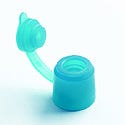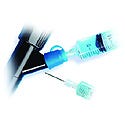September 17, 2006
Originally Published MPMN September 2006
PROFILE
Semidisposable Biopsy Valves May Be Safer with Use of TPEs
Endoscope components made with medical-grade elastomers maintain tight seals
|
Thermoplastic elastomers (TPEs) used in biopsy valves adds ozone resistance and UV stability. |
One of the many product categories where disposables have become popular is endoscopes used for the exploration or biopsy of organs and tissue. Silicone biopsy valves used in standard endoscopic procedures have been marketed as semidisposable. The valves are to be cleaned and disinfected or sterilized prior to use and reuse. However, medical personnel say that the valves are difficult to clean.
Biopsy valves, by nature of their design, have seals that help sweep off blood and bodily fluids as the sample is withdrawn from the biopsy channel. However, remaining biomaterials can collect within the internal nooks, crannies, and crevices of the valve. Because of the valves’ complex design, these biomaterials cannot be removed with a standard cleaning brush. This results in areas that can harbor dangerous pathogens. Since reprocessed silicone biopsy valves can stretch and leak, healthcare professionals can be exposed to dangerous and potentially infectious fluids.
One company came up with a solution to this problem. US Endoscopy (Mentor, OH; www.usendoscopy.com) specializes in device design and manufacturing of accessories for gastrointestinal endoscopy. Its BioShield disposable biopsy valves are made from medical-grade thermoplastic elastomers (TPEs) supplied by GLS Corp. (McHenry, IL; www. glscorp.com). The biopsy valves ensure that patients are protected from exposure to contamination that is due to product reuse. By using TPE in the valves, US Endoscopy made a device that can provide immediate, direct irrigation without the cost of new equipment. The TPE material, coupled with the valve construction and an airtight design, has resulted in a component that reduces hissing and leaking of potentially infectious body fluids onto healthcare personnel.
|
A biopsy valve is used in endoscopy equipment to reduce leaking of potentially infectious biomaterials. |
“Our market research indicated that many users were dissatisfied with the performance of semidisposable valves with respect to leakage,” says Christopher Kaye, director of advanced engineering and polymer technology at US Endoscopy. “There was also some question as to whether the valves were being adequately cleaned.”
As a result, the firm opted to find a silicone substitute and worked to establish numerous performance standards. According to Kaye, the new material had to:
• Be easily run on the firm’s own injection molding presses on multicavity molds.
• Impart a tight seal.
• Be versatile enough to handle the design parameters and constraints in terms of softness and hardness for proper cap-to-body fit to eliminate any potential for leaks.
• Enable a tube to be bonded to the body material for units sold with irrigation tubes.
• Provide a controlled degree of tackiness for the valves to remain affixed to an endoscope.
• Be user-friendly in terms of application by medical professionals and patient safety.
• Have good colorability to differentiate the products from other valves on the market.
“After discussing our needs with several TPE formulators, we found GLS was able to provide the most suitable grade to meet FDA compliance,” says Kaye. “We achieved what we needed—ease of processing, a rubbery feel, a soft touch, and excellent colorability.” The TPE not only had the desired performance characteristics, it also had good ozone resistance and UV stability.
Kaye says that US Endoscopy has used TPEs in other product applications. Another TPE product from GLS Corp. was used in a seal on the firm’s Guardus overtube line, which is used for removing foreign bodies or impacted food from a patient’s esophagus.
Copyright ©2006 Medical Product Manufacturing News
You May Also Like




